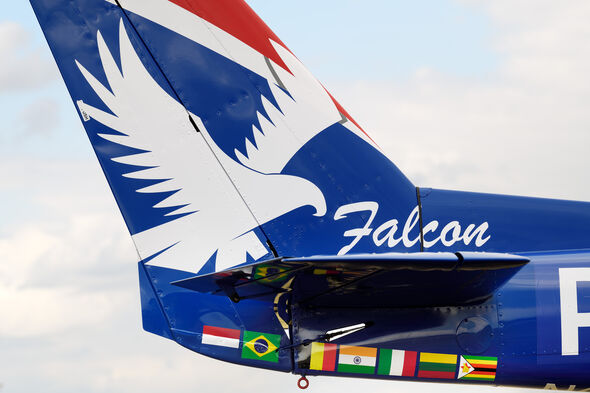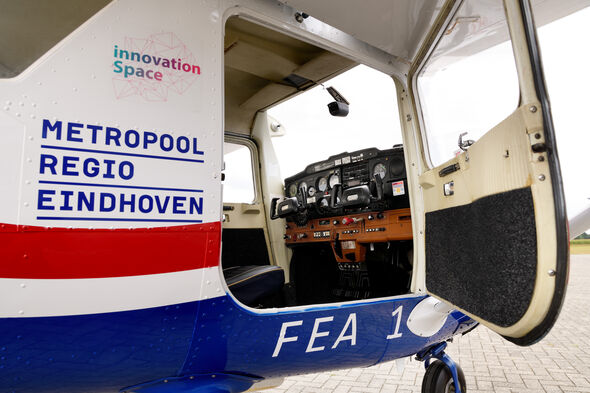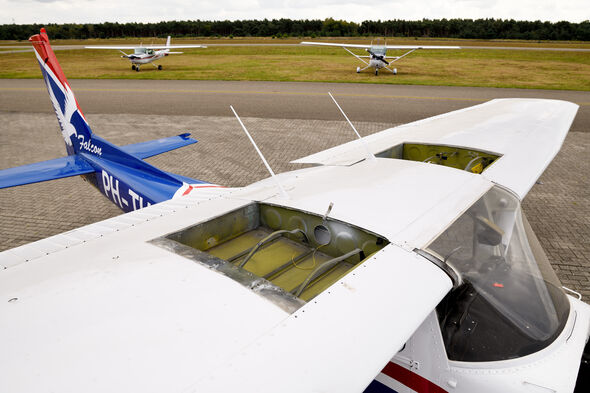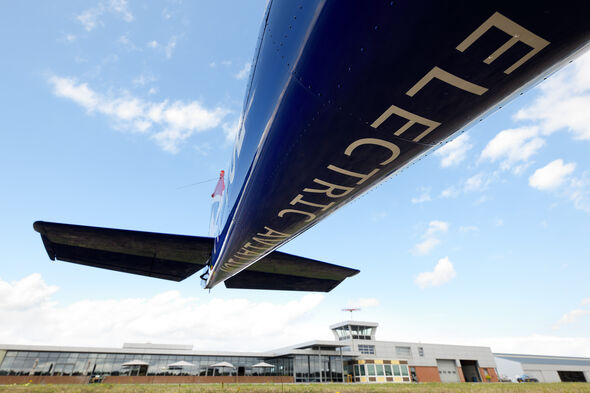
Learning to fly in a battery-powered plane
Student team is refitting existing aircraft
The Teslas among airplanes, that's what Falcon Electric Aviation (FEA) is working hard on. The TU/e student team is refitting existing aircraft with electric drives. FEA's focus is on trainer aircraft. “That is a manageable first step.”
“Elon Musk also started by converting existing cars into electric vehicles. In the meantime, that has become a billion dollar company,” says Brandon van Schaik, co-founder of Falcon Electric Aviation. “We want to do that with airplanes.” Tesla is thereby a great example for the students.
“We sat down with a few friends two years ago and talked about the energy transition. All kinds of sustainable solutions are already being thought up for cars and buses, but not so much for airplanes and boats,” Van Schaik explains. “That’s why we started looking at the possibilities for airplanes.” The students soon found out that designing and certifying a new type of aircraft costs a lot of time and money. “We don’t have that time anymore. We must work towards a more sustainable world right now,” he asserts. That is why they have looked into the possibilities of converting existing aircraft.
Falcon Electric Aviation

Brandon van Schaik (master's student of Sustainable Energy Technology and holder of a Bachelor's in Applied Physics) and Jelle Visscher (master's student of Architecture and holder of a glider pilot qualification) are two of the three founders of FEA. Falcon has been an official student team since September 2020.
Van Schaik (middle in the main photo) is the team manager of the sixteen members who between them have seven different nationalities. This is symbolized by the flags on the Falcon's tail section.
Visscher (left in the main photo) is the design manager whose other roles include managing the implementation of the batteries in the electrical power train. On the right in the photo stands bachelor's student of Mechanical Engineering Boaz Broeren. He has been a team member for over a year now. “The ten hours a week that I devote to FEA are also good for my personal development. In addition, I think it is fantastic that we are pioneers in converting an existing aircraft.”
A few years ago Van Schaik was not yet interested in aircraft, although he does think flying is a convenient and quick mode of transport. “We are trying to lose the negative aspects of flying, like the environmental pollution. This can only be done step by step. For now, if flying schools were to make the switch to electric it would be financially viable, so that is what we are proposing.”
Proof of feasibility
The first converted airplane should be ready in just over six months. “We received a subsidy from the Eindhoven Metropolitan Region. With this, we were able to demonstrate the technical and financial feasibility,” says Van Schaik. Converting an actual airplane was the best way to do this according to the student. “We are working closely with Kempen Airport in Budel in order to do this. They are also extremely interested in our project.”
Flight schools
But batteries are far too heavy to fly with, aren’t they? “Yes, it probably wouldn’t work for a Boeing 747 with 200 passengers flying to America. In any case, that still requires a lot more development,” Van Schaik admits. “But it works well on shorter flights for aircraft with room for up to twenty passengers.” The first plane that the students are going to convert into an electric plane is a Cessna 150, a two-seater plane. “We have noticed that flight schools, for example, are interested in our technology. They use these small planes a lot,” he adds. “A plane is always back on the ground after an hour’s lesson. So recharging is not an issue.”
Papa Hotel Tango Uniform Echo
The Cessna, with its old-fashioned combustion engine, was flown over to the Netherlands in March from Lydd in Great Britain. This original engine fills the entire nose of the two-seater. The electrically powered engine will be no bigger than the front wheel. At the Dutch Environment and Transport Inspectorate, which issues license plates for aircraft, the Cessna is now registered as PH-TUE.
A training plane is an ideal vehicle for FEA. “In Europe a million flying hours are clocked up every year as people train to become pilots,” explains Van Schaik. “This involves the emission of the same number of kilos of CO2 as are captured by a thousand square kilometers of forest. This would cover an area half the size of Luxemburg! For the rest, our aircraft has no nitrogen emissions and in terms of its fuel and maintenance, it is twenty times cheaper than a standard two-seater.”
It should be said, however, that it will be some time before any lessons can be taught in the Falcon. “We hope to be able to taxi in February 2021. COVID-19 permitting, at that stage we will organize a run-up event for the public,” says Visscher.
It will probably be more than a year before Papa Hotel Tango Uniform Echo can announce itself to an air traffic controller. Visscher knows from experience that getting certification involves a whole chain of bureaucratic steps.
Besides the fact that this benefits the environment, it is also interesting for flight schools in terms of price. “They can recoup the conversion package costs in about four to five years,” says Van Schaik. “Because electricity is cheaper than kerosene and given that maintenance of an electric motor is much easier than an internal combustion engine.” The conversion package is expected to cost approximately €150,000. On top of that, the batteries will have to be replaced every five years or so, because they will lose their capacity over time. “But even then it is comparatively cheaper for flight schools to fly electrically,” he points out.
What’s more, the batteries do not make the aircraft larger or heavier. “An internal combustion engine weighs about 200 kilos. An electric motor with the same capacity only weighs twelve kilos. So we can use the surplus weight for batteries,” Van Schaik adds. “The interior also remains the same. Pilots can fly both the existing and the electric planes.”

Lots of small planes
How many people fly in these types of small planes? “Most people tend to think of large passenger airplanes, but about ninety percent of all planes registered in the Netherlands are actually small planes,” he states. These are used for pleasure flights, flying lessons and business flights, for instance, says Van Schaik. “You could say that people should look for alternatives to flying, but changing human behavior is very difficult. That’s why we want to offer these people a more sustainable alternative,” he states.
The students want to contribute to the energy transition with their conversion package. “Innovation in aviation is very slow. The planes we are currently flying in were originally made in the 1960s. Since then, companies have only made modifications to the aircraft, but nothing has fundamentally changed,” Van Schaik notes. The students want to change that now. “If our plan for electric airplanes goes well, we also want to look at other options, such as hydrogen.”
“The development of hydrogen-powered aircraft is going to take a number of years,” he goes on. “But it could provide a sustainable alternative for longer flights with more passengers.” He explains that scaling-up will be difficult for electric aircraft. “You have to carry too many heavy batteries for a long flight. Besides that, the engine also has to be bigger. Since an electric motor works with magnets, it can’t become too big. In that case, the magnets would not work properly anymore,” he clarifies. “You can opt for several smaller engines, but then the aircraft will have to be built completely differently.” You wouldn’t be able to convert an airplane then. Whereas that is precisely the added value that Falcon has to offer,” says Van Schaik. Falcon wants to see how they can convert existing aircraft for hydrogen as well.
He concludes: “In order to make aviation more sustainable, just as is the case with road transportation, we have to create a combination of various sustainable options, such as electric and hydrogen-powered aviation. We want to show what the possibilities are and bring this to the market in the most accessible way possible.”
EVP Audience Award
This summer Brandon took part in ‘the online trip run by the European Venture Programme’. “Instead of going to Munich, Lausanne and Paris, I spent two weeks taking workshops in Kennispoort, together with three founders of Eindhoven-based startups [ namely, Hable, GOAL 3 and Zavhy - ed.]. I learned to make a pitch and got a ton of information that was all new to me, as a physics student. About negotiating with various parties, for example.” The lesson on pitching certainly hit the mark: FEA won the audience award.



Discussion